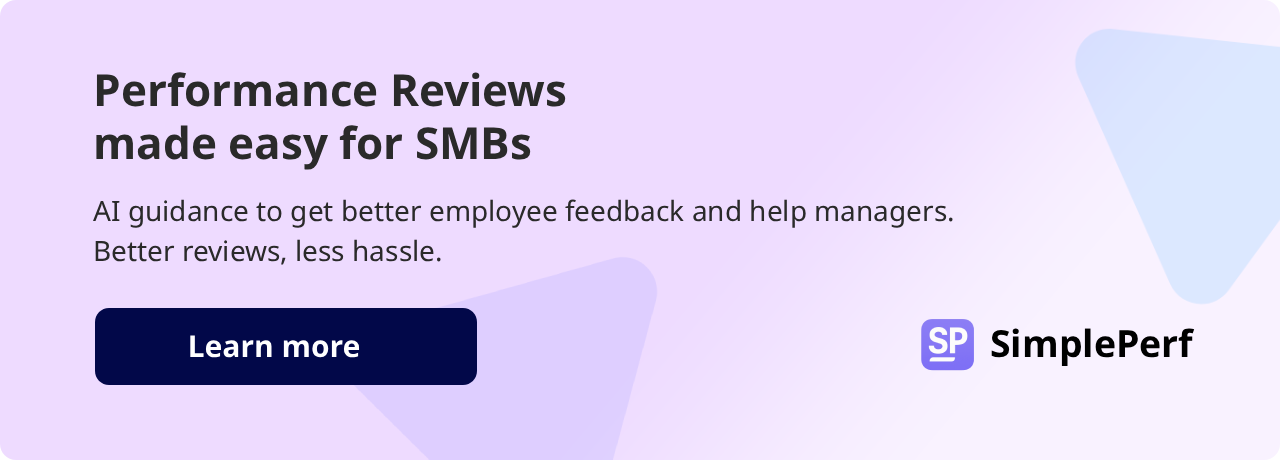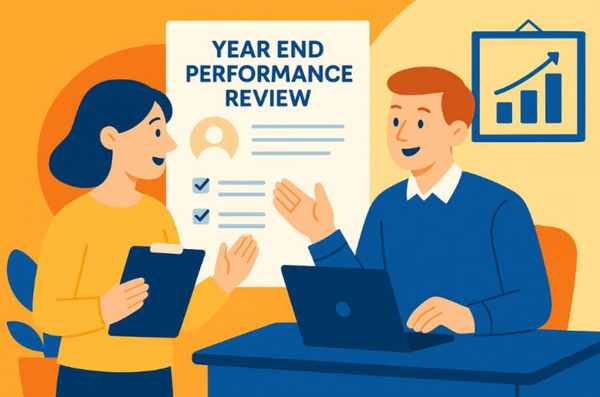Performance review tips for managers: Tips to keep in mind
Most performance reviews don’t work. Managers stress over them, employees get anxious, and CEOs barely trust the process.

Looking for a simple performance review software?
Checkout SimplePerf! Made for small teams and first-timers, SimplePerf is a simple 360 performance review software. Built for HRs, Loved by managers.
Most performance reviews don’t work. Managers stress over them, employees get anxious, and CEOs barely trust the process. In fact, only 13% of people say their review process actually helps. That’s not great. So why do we keep doing them?
Because deep down, we know they’re supposed to matter. They’re meant to build trust and help people grow. But somewhere along the way, performance reviews got too stiff—all theoretical and not nearly useful enough.
This guide is here to change that. Whether you're just starting to build your review process or trying to fix one that’s gone off-track, there’s something here worth your time. Keep reading!

Start with your own mindset
Before you start looking through goals, metrics, or feedback, ask yourself: Am I here to judge or to coach? That distinction is very important. A performance review can either make someone shut down or open up, and a lot of that depends on how you show up.
Start by checking for bias:
- Are you carrying frustration from a recent project?
- Are you overly focused on one standout moment (good or bad) and letting it skew everything else?
Take a step back and look at the big picture.
Then, be intentional with tone. If your framing sounds like judgment, you’ll get surface-level answers. But if you lead with curiosity and keep the focus on growth, you're way more likely to have an honest, helpful performance review conversation.
This is a chance to reset and help someone grow, so bring the mindset of a partner, not a referee.
Do the prep properly
Most reviews go off the rails before they even start. If you’re trying to remember what your employee worked on three months ago, the conversation is already off-track.
So, for more effective performance reviews, try reviewing past performance and feedback:
- What did you both agree to focus on last time?
- Did they meet those goals, exceed them, or not meet them at all?
Look at important wins, stalled projects, missed targets, whatever helps you see the full story.
Next, gather peer or 360 feedback if it's part of your process. You don’t need a novel, just a few outside perspectives to help you spot patterns or blind spots.
Then, ask the employee themselves for a self-assessment in advance. It gives them space to reflect and gives you a glimpse into how they see their progress. Sometimes their take will change how you approach the whole conversation.
Lastly, write down a few anchor points you want to touch on. That way, you’re walking into the room informed and focused, not flipping through old emails while they wait.
This kind of prep shouldn't be perfect or time-consuming, but it does need to be thoughtful. That alone changes the tone (and the outcome) of everything that follows.
Make it a conversation, not a performance
Sometimes, employee performance reviews feel like one person reading a script while the other nods and waits for it to end. But that's a wasted opportunity.
Learn how to listen, not just talk. Real listening means putting the phone away, making eye contact, and staying present. It means letting someone finish a thought without rushing to fix it. You could try asking:
“What part of your work are you most proud of lately?”
It’s a simple question, but it does a lot. You’ll hear what lights them up, what they think matters, and maybe even catch the start of something deeper, like frustration over a project or a colleague.
Listening doesn’t mean being passive. Ask follow-ups and paraphrase what you heard to make sure you got it right. Show them you're not just here to talk to them but that you truly want to help them grow.
When employees feel heard during a review, they’re more likely to stay engaged, bring issues up early, and act on the feedback you give. That trust will make the next three months of work much more fruitful.
Give actionable feedback
The quickest way to ruin a review is to give vague, generic feedback. Saying “You need to be more proactive” or “Improve communication” means nothing without context, and it usually leaves employees feeling confused or criticised without direction.
Instead, get specific. Like this:
“In the client handover on March 5th, you pointed out the handoff issue before it became a problem. That’s what good communication looks like. Good job.”
That’s constructive feedback they can recognise, repeat, and build on.
Also, make sure you’re talking about behaviours, not personality. Don’t say “You’re too passive.” Say:
“ In meetings, you usually hold back your ideas. I’d love to hear you speak up earlier when we’re making decisions.”
And above all, make your performance feedback actionable. What should they do more of? What should change? Tie it to a habit, a system, or a specific moment. If they leave the room wondering “what now?”, you've missed the point.
Addressing poor performance is harder, but not impossible. Stay calm, use facts, and leave room for their side of the story. Then work on a plan, not a lecture, because the goal is course correction, not shame.
If you're using BuddiesHR’s performance management software, this part gets a whole lot easier. You’ve got examples, context, and a feedback trail ready to go.
Anchor goals to growth
A performance review that only looks backward is missing half the point. More value lies in what happens next, and that starts with setting goals that mean something.
Vague goals like “take more initiative” or “be better at teamwork” don’t help anyone. They’re hard to measure, easy to misinterpret, and usually forgotten in a week. SMART goals (Specific, Measurable, Achievable, Relevant, Time-bound) are still one of the best ways to keep things focused without getting overly complicated.
But don’t just hand them down like a checklist. Co-create them. Ask:
- “What’s one area you’re curious to get better at in this quarter?”
- “How can we tie that into the team’s priorities or upcoming projects?”
When the goals are personal and aligned with business needs, people tend to care more. They see where they’re headed and how it fits into the bigger picture.
Also, don’t let this become another lost bullet point in a shared doc no one opens again. Write goals down somewhere easy to revisit, especially during 1:1s. You can use Pulsy for ongoing feedback and Linky to keep roles clear, to avoid rewriting objectives every quarter or losing track of what was discussed.
Double down on strengths
It’s easy to spend a review picking apart what went wrong. But if you skip over performance appraisals, you’re overlooking your biggest asset: the employee’s strengths.
If someone is consistently great with clients, untangles messy projects, or keeps the team grounded under pressure, say something. That kind of value deserves more than a quick “nice job.”
And once you’ve named the strength, take it further by asking:
- “How can we use this more?”
- “Would you be up for mentoring others in this area?"
- “Should we look at expanding your role so you can lead more here?”
Recognition might not be common in many workplaces, but employees are more likely to see continuous improvement when they feel seen for what they’re great at.

Follow up, or don’t bother
You had the conversation. Great. Now what?
Too many reviews die because there's no follow-up or a reminder. Just a vague sense that “we should revisit this later.” Don’t leave it open-ended. Book the follow-up before the meeting ends. Choose a date to revisit goals, check on progress, and talk through any blockers. This shows you’re serious about their development, and it keeps the momentum going.
Then get specific about timing. If a goal is meant to be hit in 60 days, decide now when you’ll check progress. It gives your team a rhythm and gives you a reason to follow up without feeling like you’re micromanaging.
And speaking of tracking, you don’t need a dozen spreadsheets to stay organised. BuddiesHR's Pulsy lets you set reminders, document feedback, and monitor goals from inside your Slack workspace.
The best managers don’t treat reviews like one-off events. They weave them into everyday conversations. A quick “How’s that stretch project going?” or “Still feeling good about the Q2 goal?” keeps the review alive without making it formal.
Final Checks: fairness, bias, and accountability
Before you wrap up the review process, take a minute to check yourself. Even with the best intentions, it’s easy to slip into bias without realising it.
For example, are you focusing too much on what happened last week instead of the entire review period? That’s recency bias. Or maybe you’re giving more credit to the people you work closest with. That's proximity bias, and it’s especially common in hybrid teams. Even shared personality traits or how someone communicates can influence your feedback.
Also, never compare employees to each other. Reviews should be about the person’s performance against expectations, not how they stack up next to their teammate. Comparison breeds resentment, not improvement.
Your job as a manager is to keep reviews consistent across your team, without making them cookie-cutter. That means using the same standards, applying them fairly, and still making space for each person’s context, role, and growth path.
At the end of the day, a great performance review is fair and motivating. It should help people see where they stand and believe that what comes next is within reach.
Make reviews worth doing
Performance evaluations are one of the few recurring moments where managers can truly move a team forward. But they only work if they’re handled with consistency and a genuine intent to support.
When done right, annual performance reviews can turn into a powerful rhythm of progress. Whether you’re refining an existing system or starting fresh, the key is to stay human, stay specific, and follow through.
BuddiesHR tools can take the chaos out of tracking and help you focus on building a team that feels supported and motivated to grow. Make it count, because when it comes to retention, a good review is worth its weight in gold.





